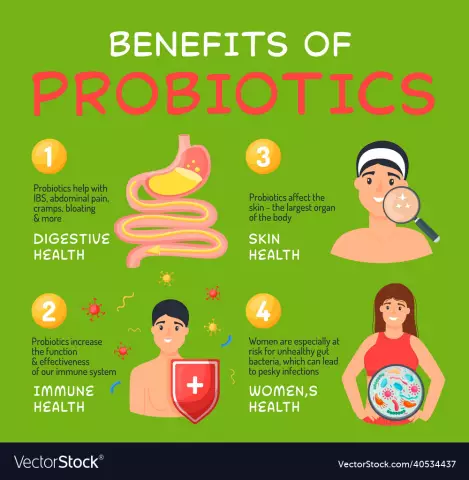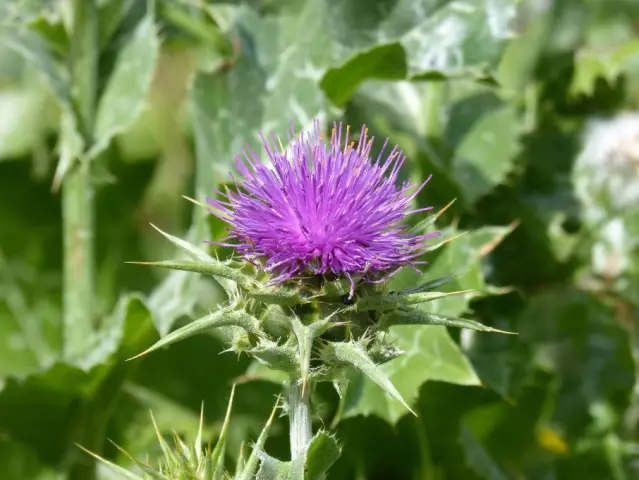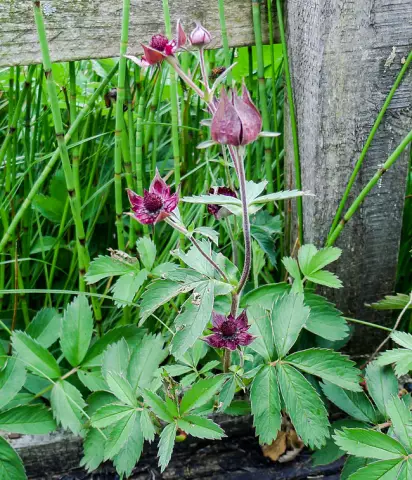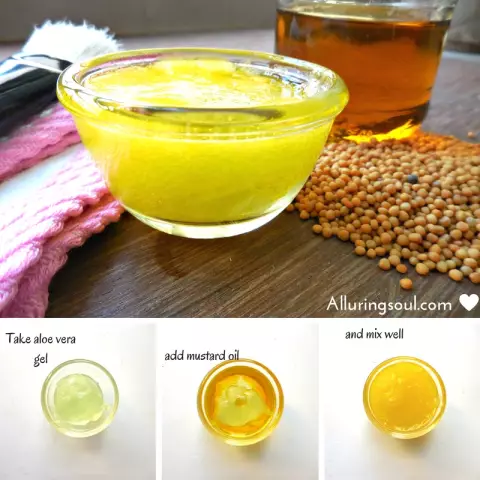- Author Rachel Wainwright [email protected].
- Public 2023-12-15 07:39.
- Last modified 2025-11-02 20:14.
Articaine INIBSA
Articaine INIBSA: instructions for use and reviews
- 1. Release form and composition
- 2. Pharmacological properties
- 3. Indications for use
- 4. Contraindications
- 5. Method of application and dosage
- 6. Side effects
- 7. Overdose
- 8. Special instructions
- 9. Application during pregnancy and lactation
- 10. Use in childhood
- 11. In case of impaired renal function
- 12. For violations of liver function
- 13. Use in the elderly
- 14. Drug interactions
- 15. Analogs
- 16. Terms and conditions of storage
- 17. Terms of dispensing from pharmacies
- 18. Reviews
- 19. Price in pharmacies
Latin name: Articaine INIBSA
ATX code: N01BB58
Active ingredient: articaine (Articaine), epinephrine (Epinephrine)
Manufacturer: Laboratory Inibsa, SA (Laboratorios Inibsa S. A.) (Spain)
Description and photo update: 2019-10-07

Articaine INIBSA is a local anesthetic.
Release form and composition
Dosage form - injection solution: transparent, slightly colored or colorless, without mechanical impurities (1.8 ml in a cartridge made of colorless borosilicate glass, which has a gray elastomer plunger at one end, and an elastomer disc at the other end and a corresponding rolling with an aluminum cap with anodized coating, 10 cartridges each in a hermetically sealed cell contour packaging made of transparent thermoplastic and laminated paper, in a cardboard box, 10 packs, complete with instructions for the use of Articaine INIBSA).
Composition of 1 ml solution:
- active substances: articaine hydrochloride - 40 mg, epinephrine hydrotartrate (in terms of epinephrine) - 0.005 * or 0.01 ** mg;
- auxiliary components: sodium hydroxide, sodium metabisulfite, sodium chloride, hydrochloric acid, water for injection.
* Corresponds to the content of epinephrine in a solution of 1: 200,000.
** Corresponds to the content of epinephrine in a solution of 1: 100,000.
Pharmacological properties
Pharmacodynamics
Articaine INIBSA is a combination drug. Its therapeutic effect is due to the properties of the active ingredients:
- articaine hydrochloride - a local anesthetic of the amide type of the thiaphene group;
- epinephrine hydrotartrate is a vasoconstrictor.
The drug has a local anesthetic effect. The effect develops within 1-3 minutes after injection and lasts for at least 45 minutes.
It has a minimal vasoconstrictor effect. It is characterized by good tissue tolerance.
Epinephrine is a part of Articaine INIBSA in a small dose, so its effect on the cardiovascular system is minimal (no significant increase in blood pressure and an increase in heart rate were noted).
Pharmacokinetics
Articaine is characterized by high diffusion capacity when administered submucosally in the oral cavity. It binds to plasma proteins by 95%.
The half-life from the body is 25 minutes.
The active substances of Articaine INIBSA penetrate the placental barrier in minimal amounts, almost not excreted in breast milk.
Indications for use
Articaine INIBSA is used for infiltration and conduction anesthesia in dentistry (especially in patients with concomitant severe somatic diseases), including when the following manipulations are necessary:
- uncomplicated extraction of one or more teeth;
- preparation of carious cavities and teeth before prosthetics.
Contraindications
Absolute:
- angle-closure glaucoma;
- bronchial asthma with hypersensitivity to sulfites;
- paroxysmal tachycardia and other tachyarrhythmias;
- hyperthyroidism;
- severe liver failure (porphyria);
- hypoxia;
- methemoglobinemia;
- B 12 - deficiency anemia;
- the simultaneous use of non-selective beta-blockers, tricyclic antidepressants or monoamine oxidase (MAO) inhibitors;
- intolerance to sulfo groups;
- children under 4 years of age;
- hypersensitivity to any component of Articaine INIBSA or sulfites.
The drug should be used with caution in children, in patients with diabetes mellitus, arterial hypertension, renal failure and cholinesterase deficiency.
Articaine INIBSA, instructions for use: method and dosage
In case of uncomplicated extraction of the upper jaw teeth (without the presence of an inflammatory process), Articaine INIBSA is injected into the transitional fold from the vestibular side in a dose of 1.8 ml for each tooth. In some cases, to achieve complete anesthesia, an additional injection of 1-1.8 ml of the drug is required.
Painful palatal injections are usually not necessary. To provide anesthesia for palatal incisions and sutures to create a palatal depot, approximately 0.1 ml of solution is required per injection.
In the case of strangulation of several adjacent teeth, the number of injections can usually be reduced.
When removing premolars of the lower jaw (without the presence of an inflammatory process), mandibular anesthesia is usually not required, since infiltration anesthesia, which is provided by the introduction of 1.8 ml of Articaine INIBSA, is usually sufficient. If the required effect is absent, an additional injection of 1-1.8 ml of the drug is performed into the submucosa - into the region of the transitional fold of the lower jaw from the vestibular side. If the desired effect cannot be achieved in this case, a mandibular nerve block is required.
For the preparation of a carious cavity or preparation for the crown of any tooth, except for the lower molars, Articaine INIBSA is used as infiltration anesthesia from the vestibular side. It is injected in a volume of 0.5 - 1.8 ml for each tooth, the exact amount of the drug is determined depending on the desired depth of anesthesia and the duration of the procedure. For one treatment procedure, the allowed dose for adults is 7 mg of articaine per kg of body weight. The duration of anesthesia is 30-45 minutes.
In children, the amount of drug administered depends on age, body weight and method of anesthesia. The maximum dose for patients aged 4-12 years should not exceed 5 mg / kg (for articaine).
Recommended doses for children (depending on body weight):
- 20-30 kg: 0.25-1 ml (1 / 6-1 / 4 cartridges). The maximum single dose is 1.5 ml, the daily dose is 2.5 ml;
- 30-45 kg: 0.5-2 ml (1 / 3-1 cartridge). The maximum single dose is 2 ml, the daily dose is 5 ml.
Side effects
Articaine INIBSA is generally well tolerated. However, in some cases, it can cause the following side effects:
- on the part of the heart and blood vessels: moderately pronounced hemodynamic disturbances (decreased blood pressure, bradycardia, tachycardia, depression of cardiovascular activity), which in some cases can cause collapse and cardiac arrest;
- from the central nervous system: impaired consciousness (up to loss), muscle tremor, respiratory failure (up to a stop), nausea, vomiting, involuntary muscle twitching (in some cases, it can progress to generalized seizures);
- on the part of the organ of vision: rarely - blurred eyes, diplopia, transient blindness;
- local reactions: inflammation, swelling at the injection site; with accidental intravascular injection - ischemia at the injection site, sometimes progressing to tissue necrosis; if a nerve is damaged (due to a violation of the injection technique), paralysis may develop;
- allergic reactions: itching, skin redness, rhinitis, conjunctivitis, angioedema of varying severity (including urticaria, swelling of the cheeks and / or upper and / or lower lip, swelling of the glottis with difficulty swallowing, difficulty breathing) - all of these reactions can progress before anaphylactic shock;
- others: often - headaches (probably due to the action of epinephrine); extremely rare - the characteristic effects of epinephrine, such as increased blood pressure, arrhythmia, tachycardia.
Overdose
In the event of the appearance of any symptom of a developing side or toxic effect (impaired consciousness, motor restlessness, dizziness), the administration of Articaine INIBSA is urgently stopped and the patient is placed in a horizontal position. It is necessary to carefully monitor hemodynamic parameters (blood pressure and pulse), as well as airway patency. Even with seemingly uncomplicated disorders, you should prepare everything you need for intravenous (IV) infusion and, at least, perform venipuncture.
Depending on the degree of impaired respiratory function, oxygen is supplied or artificial respiration is performed, if necessary - endotracheal intubation with controlled ventilation.
The use of centrally acting analeptics is contraindicated. With the development of involuntary muscle twitching or generalized seizures, ultrashort or short-acting barbiturates are slowly injected intravenously, constantly monitoring respiration and hemodynamics. Through a pre-installed cannula, intravenous fluid is simultaneously infused. Oxygen is also given to the patient.
In the case of a pronounced decrease in blood pressure, the development of tachycardia or bradycardia, the patient should be given a horizontal position with raised legs.
In severe circulatory disorders and shock, oxygen is inhaled, glucocorticoids are administered intravenously (for example, methylprednisolone at a dose of 250-1000 mg), and balanced electrolyte and plasma-substituting solutions are intravenously infused.
In case of threatening vascular collapse and increasing bradycardia, adrenaline at a dose of 0.0250.1 mg (0.25‒1 ml of a solution with a concentration of 0.1 mg / ml) is slowly injected intravenously, controlling the pulse and blood pressure. For 1 time, the introduction of no more than 0.1 mg of adrenaline (1 ml of solution) is allowed. If additional doses of epinephrine are needed, it should be added to the infusion solution. The infusion rate depends on the blood pressure and heart rate.
Severe forms of tachyarrhythmia and tachycardia can be eliminated with antiarrhythmic drugs, with the exception of non-selective beta-blockers. The use of oxygen is also required. In the case of an increase in blood pressure in patients with arterial hypertension, the appointment of peripheral vasodilators may be required.
special instructions
Each drug cartridge is intended for individual use. Do not use damaged cartridges. Do not inject into the area of inflammation. You can not enter Articaine INIBSA intravenously.
To avoid intravascular injection, an aspiration test must be performed when injecting the drug.
Local and regional anesthesia should be performed by a qualified specialist trained in the technique of performing anesthesia, familiar with the diagnosis and treatment of side effects, toxic reactions and other complications. Anesthesia should be carried out in a room where there are necessary medications and equipment for resuscitation and cardiac monitoring.
Articaine contains sulfites, which can enhance anaphylactic reactions. Hypersensitivity to sulfites is more common in patients with bronchial asthma.
In persons with cholinesterase deficiency, Articaine INIBSA can be used only in the presence of urgent indications, since there is a high risk of prolongation and enhancement of its action.
In the following cases, it is recommended to use a drug containing a smaller amount of epinephrine: the presence of severe anxiety, diseases of the cardiovascular system (arterial hypertension, heart rhythm disturbances, angina pectoris, coronary artery disease, a history of myocardial infarction, chronic heart failure), cerebrovascular disorders, diabetes mellitus, hyperthyroidism, emphysema, chronic bronchitis, a history of paralysis.
Influence on the ability to drive vehicles and complex mechanisms
According to the results of special tests, Articaine INIBSA does not have a negative effect on the cognitive and psychomotor functions of a person. However, preoperative anxiety can affect the patient's condition, so the degree of restrictions on driving a car and performing potentially dangerous types of work is determined by the dentist individually.
Application during pregnancy and lactation
The safety of using Articaine INIBSA in pregnant women has not yet been precisely established, so caution must be exercised. When treating female patients, the doctor should take into account possible pregnancy, especially the first months.
The active substances of Articaine INIBSA in significant quantities do not penetrate into breast milk, therefore, breastfeeding mothers do not need to interrupt feeding while using the drug.
Pediatric use
Articaine INIBSA should be used with caution in pediatric patients. The efficacy and safety of the drug in children under 4 years of age has not been established, therefore its use in patients of this age category is contraindicated.
With impaired renal function
In persons with renal insufficiency, Articaine INIBSA should be used with caution.
For violations of liver function
Articaine INIBSA is contraindicated in severe liver failure (porphyria).
Use in the elderly
There is no data indicating the need to adjust the dose of Articaine INIBSA for elderly patients.
Drug interactions
Articaine INIBSA should not be used in patients receiving non-selective beta-blockers, since this combination increases the risk of severe bradycardia and hypertensive crisis.
MAO inhibitors and tricyclic antidepressants can enhance the hypertensive effect of sympathomimetic amines such as adrenaline. Interactions of this type are also dangerous for norepinephrine and epinephrine when used as vasoconstrictors at concentrations of 1: 80,000 and 1: 25,000, respectively.
Analogs
Analogues of Articaine INIBSA are: Articaine DF, Articaine with adrenaline, Artifrinum, Brilocaine-adrenaline, Alfakaine SP, Orablok, Primacaine with adrenaline, Septanest with adrenaline, Ubistezine, Ultracaine D-S, Certacaine, Cytokartin, etc.
Terms and conditions of storage
Keep out of the reach of children, dry, protected from light at a temperature not exceeding 25 ° C.
Shelf life is 2 years.
Terms of dispensing from pharmacies
Dispensed by prescription.
Reviews of Articaine INIBSA
According to reviews, Articaine INIBSA is a good anesthetic used in dentistry. The drug quickly relieves pain and is well tolerated, there are no complaints about the development of side effects.
Price for Articaine INIBSA in pharmacies
The approximate price for Articaine INIBSA, a solution for injection with an epinephrine content of 1: 200,000, is 4,900 rubles. for a pack of 100 cartridges.

Anna Kozlova Medical journalist About the author
Education: Rostov State Medical University, specialty "General Medicine".
Information about the drug is generalized, provided for informational purposes only and does not replace the official instructions. Self-medication is hazardous to health!






